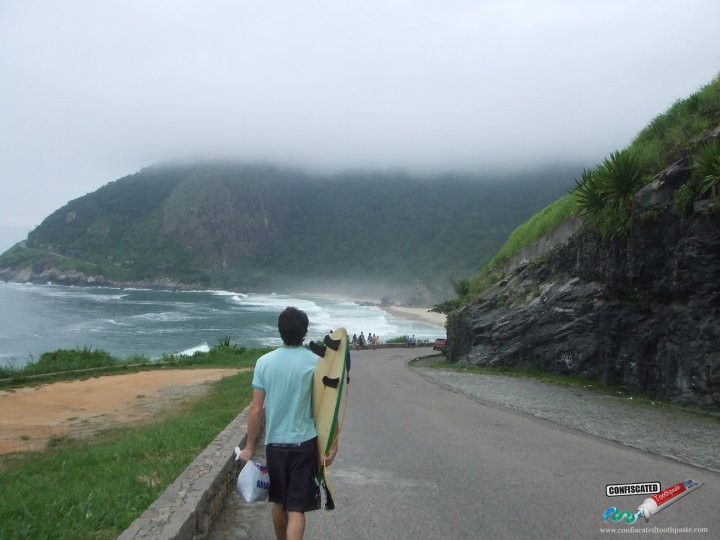Surfing in Rio de Janeiro
It’s a humid morning in Rio, and still cool but with the promise of oppressive heat in the air. My fiance and I wander through the jungle-city streets with our surfboards, attracting only cursory glances from early morning risers and those who are yet to go home after a night of partying. We reach the bus stop and there are a few others standing around I can’t quite help feeling slightly awkward. It’s been years since, as a grommet with no drivers licence, I’d caught buses with my surfboard back in Sydney. But then the big orange surf bus comes thundering down the street with impressive punctuality for Brazil. The see us with the boards and stop. The door opens and the sounds of Bob Marley waft out into the Rio morning. The driver, looking not unlike Otto from the Simpsons, gives us a friendly “Oi” and waves us aboard.
The bus is fitted out for people and surfboards. The back of the bus has racks all down the sides and they are almost completely filled with boards. Sitting everywhere are loads of grommets and grommets at heart chatting excitedly. There is swell and no wind. Everybody is stoked and sure it’s going to be a good day. Some surf videos play on the bus TV screen and the music is pumping.
If you’ve ever been to Rio, you’ll know that one of the nicest things to do is to cruise down the coast past the city and all the beaches. The bus starts at Flamengo, cruising past Botafogo and Copacabana. It then turns the corner along Ipanema and then Leblon where we get on. Through the tunnel in the Two Brother’s mountain, the bus comes to São Conrado, close to the Rochinha favela and where the waves start getting good. Barra de Tijuca, Recreio, and Macumba all have waves. But we are going all the way to Prainha.

The name Prainha means simply “little beach” and although it is indeed small, the huge cliffs rearing up behind the beach, with long peeling right handers thundering down the line provide a majesty more befitting. It is one of the most beautiful places I have laid eyes upon. Crystal green water, sheer rock faces with jungle tumbling down, mist settling over the headlands, and Frigate birds circling above the clifftops greet us as we hop off the bus and make our way down the road and to the beach.

My heart is in my mouth as I paddle out and see locals pulling into fast peeling rights and I couldn’t feel more gringo than at this moment. But everybody seems friendly and chatty. I just wish I understood more Portuguese so that I might be able to chat back.
A set rears up in front of me and there is nobody around. Nervously I paddle into it and it is fast. I am racing down the shoulder the wave is bigger than I expected, I feel pathetic and insignificant on this thing. I see the foamball racing towards me and not knowing what else to do I pull into the barrel and get smashed. I pop up and there is whitewater all around- wow, what a rush. I paddle back out and only get another two or three of these in the next hour. Nonetheless, I am exhausted and satisfied. “Did you see me on that one?” I ask my girlfriend on the beach, who takes my excitement down a notch by saying “Not sure, I lost you. Were you that guy that got smashed? It kind of looked like you.” But nothing can spoil my day now.
If you go to Rio and want to get good waves, the best bet is to head to these beaches south of the city. In town, the beaches of Ipanema and Leblon can give decent waves, but usually are just a shore-break. Sometimes the banks are a bit better and you might score some shorter rides close to the points of these beaches. Probably the best break in town is Arpoador, which is located in front of the little headland between Copacobana and Ipanema beaches. The banks here are usually pretty good and there is often a crowd getting some fun waves particularly if the swell is not huge.




